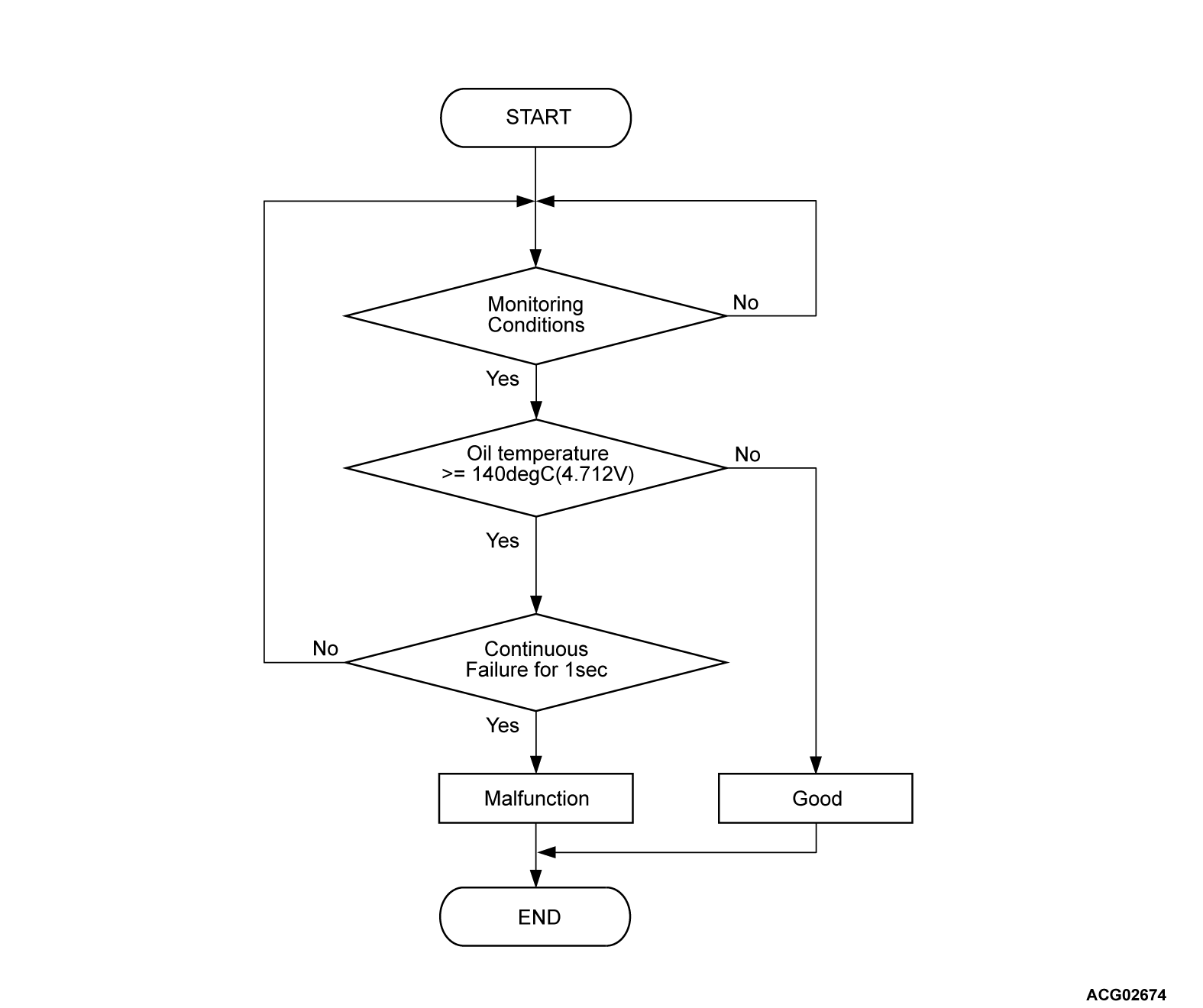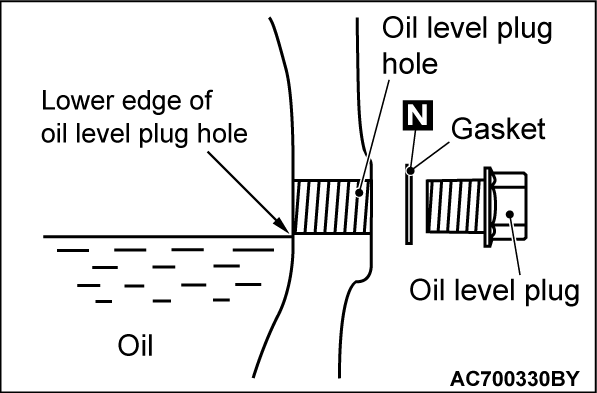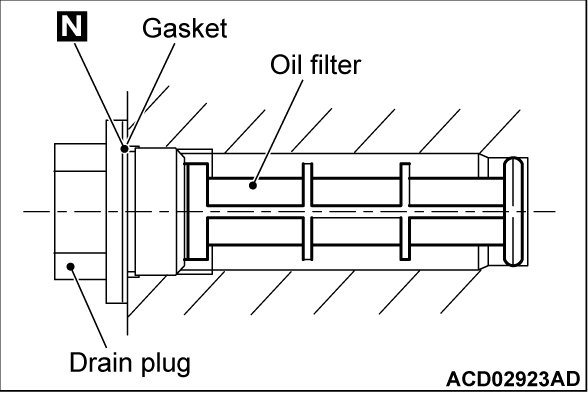DTC P1058: Generator control unit oil temperature too high
MONITOR EXECUTION
- Continuous
MONITOR EXECUTION CONDITIONS (Other monitor and Sensor)
Other Monitor (There is no temporary DTC stored in memory for the item monitored below)
- Not applicable
Sensor (The sensor below is determined to be normal)
- Drive motor oil temperature sensor
DTC SET CONDITIONS
Check Conditions
- Power drive unit (GCU) power supply voltage is 8 volts to 16 volts.
Judgment Criterion
- Change of the oil temperature is more than 140°C (284°F) (4.712 volts) for 1 second.
PROBABLE CAUSES
- The oil cooling system fails
- Oil filter clogging
- Pipe clogging
- Electric oil pump relay abnormality
- Electric oil pump related harness abnormality
- The thermistor oil temperature circuit fails
- The generator fails
- Malfunction of the power drive unit [generator control unit (GCU)]
DIAGNOSIS
Required Special Tools
- MB991223: Wiring harness set
- MB992006: Extra fine probe
STEP 1. Using scan tool (M.U.T.-IIISE), check whether the DTC is set.
Check whether the power drive unit [generator control unit (GCU)] set a DTC P105C, P105B or P10AE which is related to the electric oil pump.
Is the DTC set?
STEP 2. Using scan tool (M.U.T.-IIISE), check whether the other DTC is set.
Check whether the PHEV-ECU set a DTC P0691, P0692, P0693, P0694, P10DE or P10DF which is related to the fan, fan motor and fan shroud assembly.
Is the DTC set?
STEP 3. Check the resistance in the coil temperature sensor.
(1) Disconnect the power drive unit connector.
(2) Check the conduction of the harness between the power drive unit and the generator and measure the resistance value of the oil temperature sensor in the power drive unit connector terminals.
|
Is the check result normal?
STEP 4. Using scan tool (M.U.T.-IIISE), check the actuator test.
Check the following actuator test (Refer to GROUP 54Da - PHEV-ECU - Actuator Test Reference Table  ).
).
 ).
).- Item No.3: Radiator fan relay 1 actuate
- Item No.4: Radiator fan relay 2 actuate
Is the check result normal?
STEP 5. Check the EV oil cooler.
Visually check that there is no abnormality such as a dent or deformation in the fin of the EV oil cooler.
Is the check result normal?
STEP 6. Check the oil level.
Check that the oil level is at the lower edge of the oil level plug hole.
Is the check result normal?
STEP 7. Oil filter check
Remove the generator drain plug, check that the oil filter behind it is not clogged or damaged. Replace the Oil filter and Oil (Refer to GROUP 14B - On-Vehicle Service <Oil Cooling System> - Oil Change
Replace the Oil filter and Oil (Refer to GROUP 14B - On-Vehicle Service <Oil Cooling System> - Oil Change  ). Then go to Step 10
). Then go to Step 10 .
. Replace the EV oil cooler hose and EV oil cooler pipe (Refer to GROUP 14B - Oil Hose and Pipe
Replace the EV oil cooler hose and EV oil cooler pipe (Refer to GROUP 14B - Oil Hose and Pipe  ), the EV oil cooler bypass valve and electric oil pump (Refer to GROUP 14B - Electric Oil Pump/EV Oil Cooler Bypass Valve
), the EV oil cooler bypass valve and electric oil pump (Refer to GROUP 14B - Electric Oil Pump/EV Oil Cooler Bypass Valve  ), the Oil filter and Oil (Refer to GROUP 14B - On-Vehicle Service <Oil Cooling System> - Oil Change
), the Oil filter and Oil (Refer to GROUP 14B - On-Vehicle Service <Oil Cooling System> - Oil Change  ). Then go to Step 10
). Then go to Step 10  .
.
Is the check result normal?
 Replace the Oil filter and Oil (Refer to GROUP 14B - On-Vehicle Service <Oil Cooling System> - Oil Change
Replace the Oil filter and Oil (Refer to GROUP 14B - On-Vehicle Service <Oil Cooling System> - Oil Change  ). Then go to Step 10
). Then go to Step 10 .
. Replace the EV oil cooler hose and EV oil cooler pipe (Refer to GROUP 14B - Oil Hose and Pipe
Replace the EV oil cooler hose and EV oil cooler pipe (Refer to GROUP 14B - Oil Hose and Pipe  ), the EV oil cooler bypass valve and electric oil pump (Refer to GROUP 14B - Electric Oil Pump/EV Oil Cooler Bypass Valve
), the EV oil cooler bypass valve and electric oil pump (Refer to GROUP 14B - Electric Oil Pump/EV Oil Cooler Bypass Valve  ), the Oil filter and Oil (Refer to GROUP 14B - On-Vehicle Service <Oil Cooling System> - Oil Change
), the Oil filter and Oil (Refer to GROUP 14B - On-Vehicle Service <Oil Cooling System> - Oil Change  ). Then go to Step 10
). Then go to Step 10  .
.STEP 8. Check the oil level.
Check the abnormal state of the oil level.
What is the abnormal state of the oil level?
: Replace the EV oil cooler hose and EV oil cooler pipe (Refer to GROUP 14B - Oil Hose and Pipe  ), the EV oil cooler bypass valve and electric oil pump (Refer to GROUP 14B - Electric Oil Pump/EV Oil Cooler Bypass Valve
), the EV oil cooler bypass valve and electric oil pump (Refer to GROUP 14B - Electric Oil Pump/EV Oil Cooler Bypass Valve  ). Then go to Step 9
). Then go to Step 9 .
.
 ), the EV oil cooler bypass valve and electric oil pump (Refer to GROUP 14B - Electric Oil Pump/EV Oil Cooler Bypass Valve
), the EV oil cooler bypass valve and electric oil pump (Refer to GROUP 14B - Electric Oil Pump/EV Oil Cooler Bypass Valve  ). Then go to Step 9
). Then go to Step 9 .
. : Remove the oil and replace all oil-cooled parts. (the front motor (Refer to  ), the generator (Refer to
), the generator (Refer to  ), the EV oil cooler (Refer to GROUP 14B - EV Oil Cooler
), the EV oil cooler (Refer to GROUP 14B - EV Oil Cooler  ), EV oil cooler hose and EV oil cooler pipe (Refer to GROUP 14B - Oil Hose and Pipe
), EV oil cooler hose and EV oil cooler pipe (Refer to GROUP 14B - Oil Hose and Pipe  ) and the EV oil cooler bypass valve and electric oil pump (Refer to GROUP 14B - Electric Oil Pump/EV Oil Cooler Bypass Valve
) and the EV oil cooler bypass valve and electric oil pump (Refer to GROUP 14B - Electric Oil Pump/EV Oil Cooler Bypass Valve  )). Then, inject new oil. (Refer to GROUP 14B - On-Vehicle Service <Oil Cooling System> - Oil Change
)). Then, inject new oil. (Refer to GROUP 14B - On-Vehicle Service <Oil Cooling System> - Oil Change  ). Then go to Step 10
). Then go to Step 10 .
.
 ), the generator (Refer to
), the generator (Refer to  ), the EV oil cooler (Refer to GROUP 14B - EV Oil Cooler
), the EV oil cooler (Refer to GROUP 14B - EV Oil Cooler  ), EV oil cooler hose and EV oil cooler pipe (Refer to GROUP 14B - Oil Hose and Pipe
), EV oil cooler hose and EV oil cooler pipe (Refer to GROUP 14B - Oil Hose and Pipe  ) and the EV oil cooler bypass valve and electric oil pump (Refer to GROUP 14B - Electric Oil Pump/EV Oil Cooler Bypass Valve
) and the EV oil cooler bypass valve and electric oil pump (Refer to GROUP 14B - Electric Oil Pump/EV Oil Cooler Bypass Valve  )). Then, inject new oil. (Refer to GROUP 14B - On-Vehicle Service <Oil Cooling System> - Oil Change
)). Then, inject new oil. (Refer to GROUP 14B - On-Vehicle Service <Oil Cooling System> - Oil Change  ). Then go to Step 10
). Then go to Step 10 .
.STEP 9. Using scan tool (M.U.T.-IIISE), check the actuator test.
| caution | When ambient temperature is -15°C (5°F) or less, the oil pump may not operate stably. Execute the actuator test only when the temperature is above -15°C (5°F). |
(2) Check for the existence of oil leakage.
Is the oil level appropriate?
![[Previous]](../../../buttons/fprev.png)
![[Next]](../../../buttons/fnext.png)


